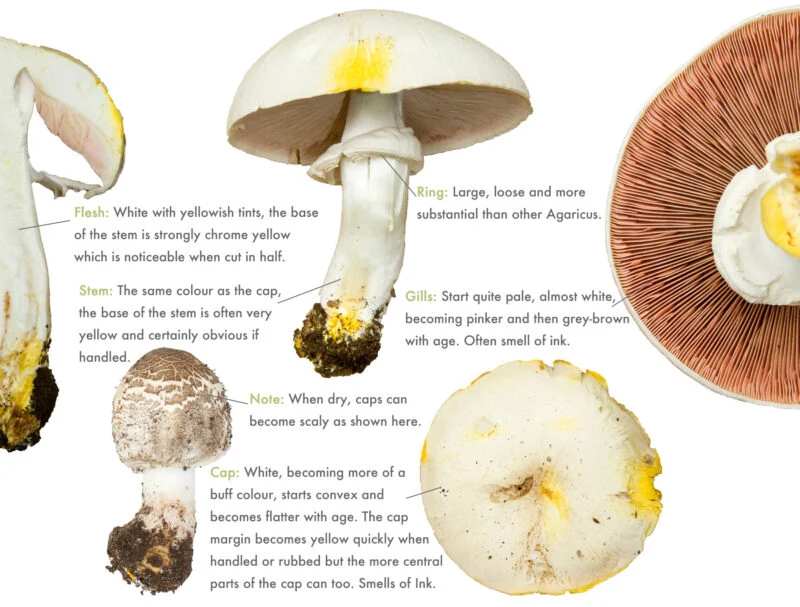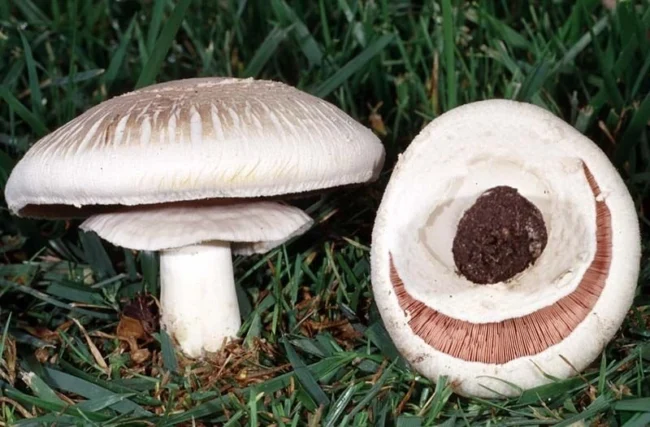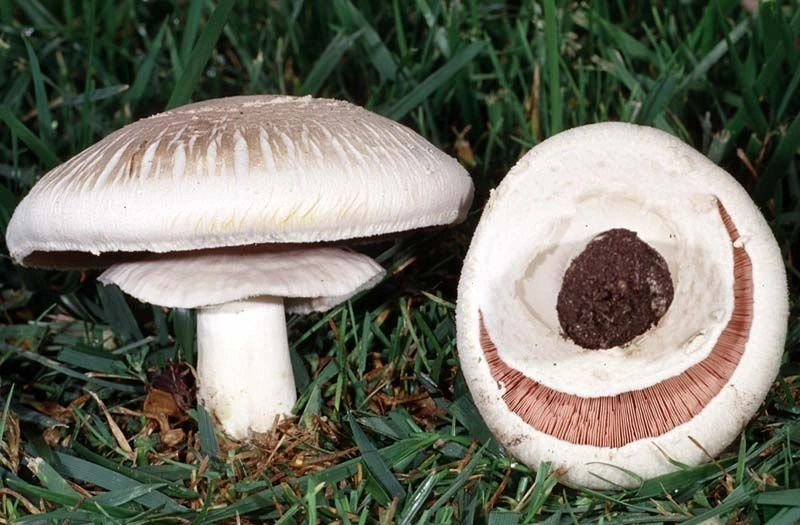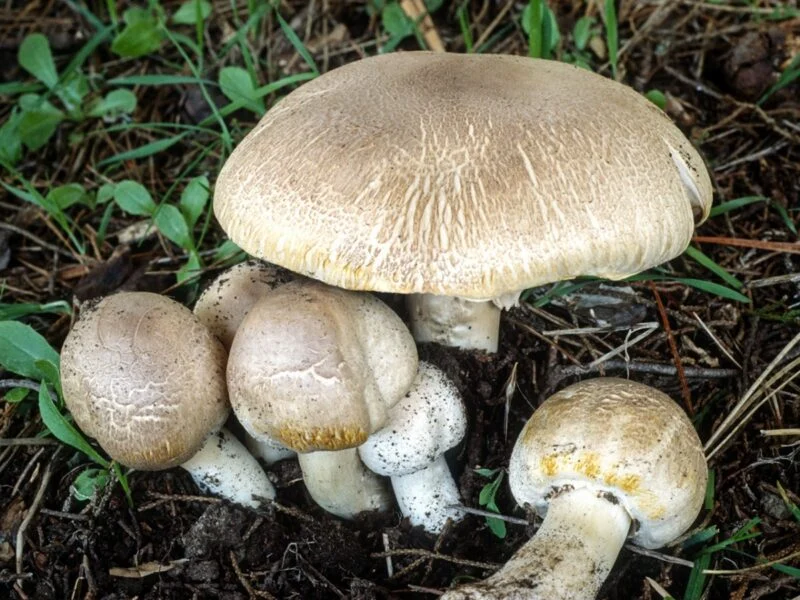Agaricus xanthodermus, commonly known as the Yellow Stainer, Yellow-Staining Mushroom, or Yellow-Skinned Champignon, is a widespread fungus often mistaken for edible species due to its superficial resemblance to common champignons. However, it is toxic and responsible for a significant portion of mushroom poisonings in regions where it grows.
First described in 1876 by French botanist Léon Gaston Genevier, this species derives its name from the Greek “xanthos” (yellow) and “derma” (skin), reflecting its characteristic yellow bruising. While not deadly, it can cause severe gastrointestinal distress, making accurate identification crucial for foragers.
Taxonomy
Agaricus xanthodermus belongs to the kingdom Fungi, a diverse group of eukaryotic organisms that play key roles in decomposition and nutrient cycling.
Synonyms include Psalliota xanthoderma, Pratella xanthoderma, Fungus xanthodermus, and variations like Agaricus xanthodermus var. lepiotoides. It is part of the section Xanthodermatei within the genus Agaricus, which includes other yellow-staining species. The genus Agaricus encompasses both edible (e.g., the button mushroom) and toxic mushrooms, with over 300 species described. Taxonomically, A. xanthodermus was distinguished from edible Agaricus species in the late 19th century based on its staining reaction and odor.
Physical description (Anatomy)
Agaricus xanthodermus is a medium-sized agaric mushroom with a classic “champignon” appearance, but distinctive features make it identifiable upon close inspection. It is saprotrophic, meaning it derives nutrients from decaying organic matter.

Cap (Pileus)
The cap measures 5–15 cm (2–6 inches) in diameter. It starts hemispherical or globose in young specimens, often with a flattened top, and expands to become broadly convex or nearly flat in maturity. The surface is dry, smooth, and matte when young, turning silky or slightly scaly with age, especially in dry conditions. Coloration is white to off-white, sometimes with light brownish tints or scales toward the center. A key diagnostic trait is that the cap bruises or stains bright chrome yellow when scratched, pressed, or bruised, later fading to brownish-yellow.
Gills (Lamellae)
The gills are free from the stem (not attached) and crowded. They begin pale pink or whitish in young mushrooms, maturing to grayish-pink, then chocolate brown or dark brown as spores develop. This color progression is typical of Agaricus species.
Stem (Stipe)
The stem is 5–15 cm (2–6 inches) tall and 1–3 cm (0.4–1.2 inches) thick, cylindrical but often bulbous or club-shaped at the base, widening up to 3–4 cm. It is white and smooth, with a prominent, skirt-like, pendulous ring (annulus) that persists into maturity. The ring is white, double-layered, and thickened at the edges. When cut, especially at the base, the stem flesh turns intensely chrome yellow, a reaction that is rapid and diagnostic.
Flesh (Context)
The flesh is firm and white throughout, but it yellows strongly when cut, bruised, or exposed to air, particularly at the stem base where it may turn brownish-yellow over time. The odor is unpleasant and phenolic, reminiscent of ink, carbolic acid (phenol), iodine, acetone, or hospital disinfectant—especially noticeable when the base is cut or during cooking. The taste is not distinctive but is reported as unpleasant; however, tasting is not recommended due to toxicity. Upon cooking, the flesh may intensify in yellow color and odor.
Spores and microscopic features
The spore print is dark brown or purple-brown. Spores are elliptical, smooth, and measure 5–7 × 3–4.5 μm. Cheilocystidia (cells on gill edges) are club-shaped. These microscopic traits aid in laboratory confirmation but are not necessary for field identification.
Habitat and distribution
Agaricus xanthodermus is a saprotrophic fungus, thriving on decaying organic matter in nutrient-rich soils. It prefers disturbed habitats such as lawns, gardens, parks, meadows, pastures, hedgerows, and the edges of woodlands or mixed forests. It often grows in grassy areas, sometimes in groups or fairy rings, and can appear in urban or suburban settings. This species favors alkaline or neutral soils and is more common in areas with human activity.
Geographically, it is cosmopolitan and widely distributed across Europe (including Britain and Ireland), North America, West Asia (e.g., Iran, Anatolia), North Africa, southern Africa, and has been introduced to Australia. In Russia and Eastern Europe, it is found in deciduous forests, parks, and meadows. It is absent or rare in very cold or arid regions but has adapted to a variety of climates.
Fruiting season
This mushroom fruits primarily in late summer to autumn, from June to October in temperate regions like Europe and North America. It appears abundantly after rains, with peak occurrences in July to early October. In warmer climates, it may extend into November.
Toxicity and poisons
Warning: Agaricus xanthodermus is poisonous and should not be consumed. It is responsible for up to 50% of mushroom poisonings involving Agaricus-like species, often due to misidentification with edible champignons.
While not fatal, it causes severe gastrointestinal syndrome (resinoid syndrome) in most people, though a small minority can tolerate it without symptoms.
Symptoms typically appear 1–3 hours after ingestion (or up to 24 hours in some cases) and include nausea, vomiting, diarrhea, abdominal cramps, sweating, flushing, chills, headache, weakness, malaise, and occasionally mild psychomotor agitation or fainting.
Recovery usually occurs within 2–4 days with supportive care like hydration, but severe cases may require medical attention. The mushroom’s unpleasant odor and taste during cooking often deter consumption.
The toxicity stems from phenolic compounds in its tissues, which are responsible for both the yellow staining and adverse effects. Chemical analyses have identified:
- Phenol: A toxic irritant causing gastrointestinal distress.
- Hydroquinone (p-quinol): Contributes to oxidative stress and irritation.
- 4,4′-Dihydroxybiphenyl: A biphenol with potential toxic properties.
- 4,4′-Dihydroxyazobenzene: A unique azo compound, the first naturally occurring endogenous azo-dye in fungi, linked to the intense yellow coloration and toxicity.
These compounds irritate the digestive tract, leading to inflammation and symptoms. Some sources speculate on gyromitrin-like toxins, but phenolic metabolites are confirmed as primary culprits. Cooking does not detoxify it; in fact, it intensifies the odor and may enhance yellowing. Even small amounts (1–2 mushrooms) can cause illness, and repeated exposure may worsen reactions.
Despite its toxicity, it has been used in folk medicine in some cultures, though this is not recommended. In regions like Victoria, Australia, it is the most commonly ingested poisonous mushroom.
Similar species
Agaricus xanthodermus is frequently confused with edible Agaricus species, leading to poisonings. Key distinctions include its rapid yellow staining and phenolic odor.
- Field Mushroom (Agaricus campestris): Edible; pink gills maturing to brown; no strong yellow staining or phenolic smell; grassy habitats.
- Horse Mushroom (Agaricus arvensis): Edible; larger cap; anise-like odor; slight yellowing but not chrome yellow.
- Pavement Mushroom (Agaricus bitorquis): Edible; urban habitats; no yellowing.
- Prince Mushroom (Agaricus augustus): Edible; almond odor; brown scales; mild yellowing.
- Wood Mushroom (Agaricus silvicola): Edible; forest habitats; slight yellowing but fruity odor.
- Other Toxic Look-Alikes: Agaricus moelleri (dark scales, phenolic smell); Agaricus placomyces (gray scales); Agaricus pilatianus (no bulbous base); Agaricus californicus (similar appearance in North America).
Always check for yellow bruising at the stem base and odor. If unsure, avoid consumption.
Additional notes and identification tips
This species grows singly or in small groups, sometimes displacing edible Agaricus in disturbed areas. For safe identification:
- Bruise test: Scratch the cap or cut the stem base—look for immediate chrome yellow.
- Odor check: Sniff the base for phenolic/ink-like smell.
- Cooking test (not recommended for consumption): Intensifies odor and yellowing.
Consult field guides, mycologists, or apps for confirmation. Agaricus xanthodermus highlights the importance of caution in foraging, as visual similarities can be deceptive. In ecosystems, it aids decomposition but poses risks to humans and pets if ingested.



